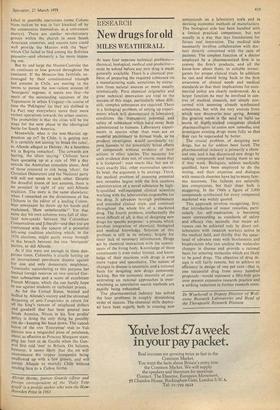RESEARCH
New drugs for old
MILES WEATHERALL
At least four separate technical problems— chemical, biological, medical and predictive— must be solved before any new drug is made generally available. There Is a chemical pro- blem of preparing the required substance on a manufacturing scale, sometimes by extrac- tion from natural sources or more usually synthetically. Pure chemical originality and great technical innovation are vital to the success of this stage, particularly when diffi- cult, complex substances are required. There is a biological problem, of setting up experi- ments which will demonstrate in laboratory conditions the therapeutic potential and safety of substances which have never been administered to humans. Laboratory experi- ments in species other than man are an essential preliminary to human trials, as no prudent investigator would continually ex- pose humans to the potentially lethal effects of compounds without evidence of their actions in other species. The necessity for such evidence does not, of course, mean that it is foolproof : man reacts like, but not al- ways exactly like, other mammalian species. In brief, the argument is by analogy. Third, the medical problem of assessing potential new remedies begins with the first cautious administration of a novel substance by high- ly-qualified well-equipped clinical scientists working with the laboratories responsible for the drug. It advances through preliminary and extended clinical trials, and continues throughout the whole life of a marketed drug. The fourth problem, intellectually the most difficult of all, is that of designing new drugs for specific purposes: a process which involves integration of chemical, biological and medical knowledge. Solution of this problem is still in its infancy, largely for sheer lack of necessary information. Drugs act by chemical interaction with the constit- uents of the living body. Knowledge of these constituents is even today limited, and know- ledge of their reactions with drugs is even more vague and speculative. The nature of changes in disease is uncertain, and a rational basis for designing new drugs commonly lacking. But the economic necessity of con- centrating on rational approaches is over- whelming as speculative search methods are rapidly being exhausted. The pharmaceutical industry has solved the four problems in roughly diminishing order of success. The chemical skills deploy- ed have been superb, both in creating new compounds on a laboratory scale and in devising economic methods of manufacture. The biological side has been handled with a limited practical competence, but not usually in a way that lays foundations for future real innovation. The medical side necessarily involves collaboration with doc- tors directly concerned with the care of patients. The simplest function of a doctor employed by a pharmaceutical firm is to convey the firm's products, and all the know-how about them, to suitable investi- gators for proper clinical trials. In addition he can and should bring back to the firm awareness of clinical needs and medical standards so that their implications for com- mercial policy are clearly understood. As a larger function he may be involved in cen- tres of medical research, not simply con- cerned with assessing already synthesised substances, but with the very sources from which new discoveries may spring. Among the greatest needs is the need to build up teams of highly-trained competent clinical pharmacologists to assess new remedies and investigate existing drugs more fully so that they can be superseded by better.
The crucial problem, of designing new drugs, has so far seldom been faced. The pharmaceutical industry is primarily a chem- ical one, and it has discovered new drugs by making compounds and testing them to see if they work. Biologists, seldom medically qualified, have been employed to do the testing, and their expertise and dialogue with research chemists have led to many fam- ous successes. The failures are naturally less conspicuous, but their sheer bulk is staggering. In the 1960s a figure of 3,000 compounds synthesised for every compound marketed was widely quoted.
This approach involves recognising, first, that introduction of minor remedies, parti- cularly for self-medication, is becoming more unrewarding as standards of safety and efficacy rise, secondly that major ad- vances can be achieved only by direct col- laboration with research workers active in the medical field, and thirdly that the spear- head of advance rests with biochemists and biophysicists who can analyse the molecular changes in disease and provide a rational basis for selecting molecules which are likely to be good drugs. The objective of drug de- sign is still fairly remote, but to achieve an efficiency in design of one per cent—that is, one successful drug from every hundred proposals—would represent a fifty-fold gain over present expensive research practice and a striking reduction in further research costs.
Dr Weatherall is Deputy Director of Well- come Research Laboratories and Head of the Therapeutic Research Division










































 Previous page
Previous page